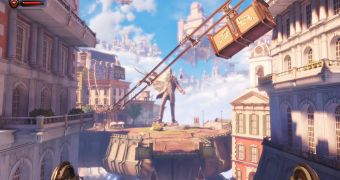After waiting quite a lot of years, BioShock Infinite has finally appeared earlier this month and we already praised it in our own review. Now, it's time to talk about specific things in this Gamer Diary series.
BioShock Infinite's main claim to fame is the unique setting of the game – Columbia, a city that floats in the sky. BioShock veterans will no doubt figure out that this is a far cry from Rapture, the main location of the first two games in the series, which was an underwater city.
Even so, you're introduced to the two cities in much the same way, as both BioShock 1 and Infinite start with the player arriving at a lighthouse. While in the first game he was forced to go down and reach a bathysphere, in Infinite he's going up some stairs to reach a sort of rocket chair.
From there, the two devices take the player and the protagonist, BioShock's Jack and Infinite's Booker, in and around their respective cities.
This procedure is great as not only does it present the two cities in a big way, but it also creates a memory of the grandeur of the two locations. While you'll be reminded of this throughout the two games by looking out the windows, you can't beat that sudden rush generated when you actually enter Rapture and Columbia.
Besides the almost identical introductions, however, both Rapture and Columbia manage to stand out, thanks to their different layouts, but also through their distinct tones.
While you reached Rapture after its downfall, you get to Columbia while it's still in its golden age, even if a class conflict is boiling under the surface. Sure, you get to see it degenerate into a civil war but you can still see its peaceful streets inhabited by regular individuals, not just by crazy splicers like in Rapture.
There are resemblances and differences, but both Rapture and Columbia will no doubt occupy a great place in the pantheon of iconic video game locations.

 14 DAY TRIAL //
14 DAY TRIAL //